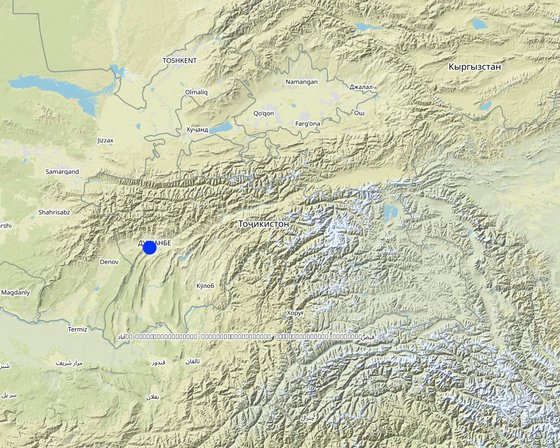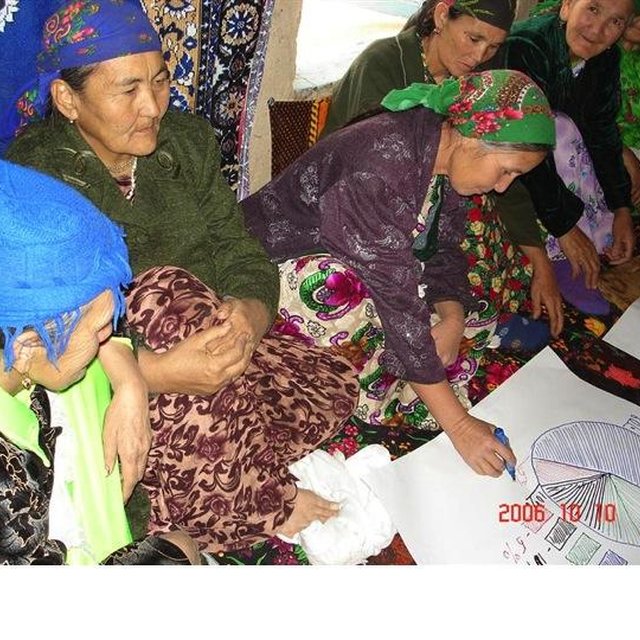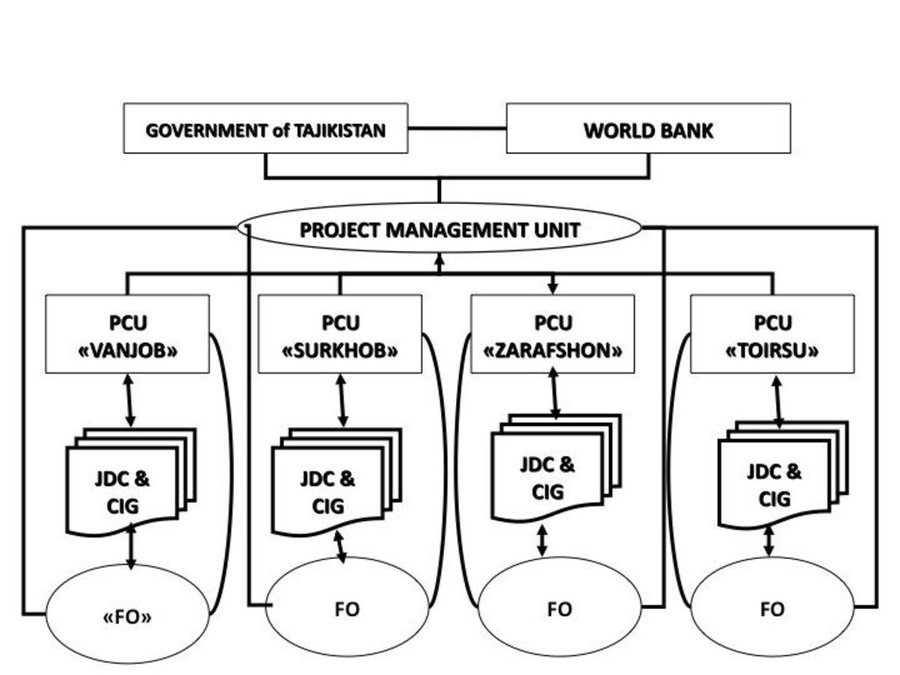Village-level participatory planning for sustainable agriculture and land management
(ทาจิกิสถาน)
คำอธิบาย
Design and implementation of participatory planning for village-level sustainable agriculture and land management investments through small grants for groups of upland farmers.
Aims / objectives: As part of the CAWMP, participatory planning aimed to generate village-based community action plans (CAPs) that identified priority investments and beneficiaries for small grants to sustainably increase rural production. A total of 402 three-year plans were developed, through which about 4000 investments in four upland project sites were funded that resulted in increased livelihood assets for over 43,000 households and more than 96,000ha under improved land management practices.
Methods: Under supervision of a government-appointed Project Management Unit (PMU), four international facilitating organizations (FOs) were contracted to work closely with local field coordination units and Jamoat (“sub-district”) Development Committees (JDCs). An operational manual laid out guidelines for developing CAPs and the management of rural production investments. Activities could be proposed for three types of investment that would increase/improve: a) farm productivity, b) land resource management and c) small-scale infrastructure to support rural production. CAPs were required to include: (i) identifiers such as a location map, numbers of beneficiaries, area covered; (ii) an indicative list of investments and associated Common Interest Groups (CIGs) by investment type and cost; (iii) estimate of labor and materials needed; (iv) estimates of beneficiary contribution for each investment and (v) list of beneficiaries resulting from the improvements, and (vi) signed agreements to participate in the cost sharing, labor provision and subsequent operation and maintenance. Within each village, fixed amounts of funding were available and were exceeded by the value of proposed investments. Thus villagers considered the available budget, number of beneficiaries and associated risks when selecting investments (see TAJ044 for details). A beneficiary contribution of at least 25% of the value of the grant was required. In some cases, FOs and JDCs obtained other financing for activities outside of CAWMP.
Stages of implementation: Key steps in the implementation included: 1) Training of facilitators in participatory planning 2) Open village assembly introducing CAWMP and the CAP guidelines; 3) Participatory rural appraisals (PRA); 4) Sharing of findings in village assembly and identification of potential rural investments; 5) Prioritizing proposals and formation of CIGs; 6) Circulation of CAP, e.g., public display in JDC offices; 7) Preparation and submission of rural investment proposals with assistance from FOs and PCUs to JDCs/JRCs for initial screening and approval; and 8) Periodic meetings to review CAPs.
Role of stakeholders: Within villages, vulnerable households were identified and appraised through the use of PRA tools, such as wealth ranking and villager consultations and often were selected as priority recipients of initial investments. During the course of the project, environmental appraisal aspects of the planning process were strengthened through additional training in tools for participatory analysis.
สถานที่

สถานที่: Jirgital, Tajikibad, Vanj, Aini, Matcha, Pendjikent, Danghar, Sughd, Region of Republican Subordination, Khatlon, Gorno Ba, ทาจิกิสถาน
ตำแหน่งทางภูมิศาสตร์ของสถานที่ที่ถูกเลือ
วันที่ริเริ่ม: 2005
ปีที่สิ้นสุด: 2012
ประเภทของแนวทาง
-
แบบดั้งเดิม/ แบบพื้นเมิอง
-
เป็นนวัตกรรมท้องถิ่นล่าสุด/ นวัตกรรมใหม่
-
ใช้โครงงานหรือแผนงานเป็นฐาน

Participatory planning and decision-making at the village level have been critical to the success of the project. Participatory rural appraisal tools have been used to engage poor and marginal groups
แนวทางการดำเนินการและบรรยากาศการพัฒนาที่เอื้ออํานวย
เป้าหมายหรือวัตถุประสงค์หลักของแนวทาง
The Approach focused mainly on other activities than SLM (participatory planning, design, implementation, village-level, small grants, sustainable agriculture, sustainable land management)
Community action plans for villages generated from a planning process that was participatory, transparent and identified and prioritised fair and feasible options for increasing rural production in ways that are environmentally sustainable.
The SLM Approach addressed the following problems: Little prior experience in communities and organisations in participatory planning for sustainable agriculture and land management, particularly in the context of limited budgets. Marginalisation of poor and vulnerable groups and lack of transparency in decision-making over allocation of funding for investments.
เงื่อนไขที่เอื้ออำนวยต่อการนำเอาเทคโนโลยีภายใต้แนวทางนี้ไปปฏิบัติใช้
เงื่อนไขที่เป็นอุปสรรคต่อการนำเอาเทคโนโลยีภายใต้แนวทางนี้ไปปฏิบัติใช้
-
บรรทัดฐานและค่านิยมทางสังคม วัฒนธรรม ศาสนา: Poor and vulnerable groups not active participants in appraisals and decision-making and do not adopt SLM practices.
Treatment through the SLM Approach: Open meetings, PRA tools to encourage active participation.
-
การมีไว้ให้หรือการเข้าถึงแหล่งการเงินและบริการ: Individual households unable to adequately invest in SLM investments.Few mechanisms to foster fairer distribution of resources along with feasible SLM options.
Treatment through the SLM Approach: Households are formed into CIGs. Transparent budget limits for types of investment encourage participants to propose fairer and feasible SLM options.
-
กรอบแนวทางในการดำเนินการด้านกฎหมาย (การถือครองที่ดิน สิทธิในการใช้ที่ดินและน้ำ): Absence of land use rights will affect sustainability of technology investments.
Treatment through the SLM Approach: Requirement that all CIGs have use rights nominally allocated. Project then assists in issuance of certificates.
The existing land ownership, land use rights / water rights hindered a little the approach implementation Very few Land Use Rights Certificates had been issued at start of project for arable land in upland areas. There was no provision for allocation of use rights to non-arable sloping lands suitable for horticulture, woodlots and other restricted access uses. However, project provisions (see 3.2.4.2) to assist in issuance of land use rights helped overcome this constraint.
-
ความรู้เกี่ยวกับ SLM การเข้าถึงการสนับสนุนด้านเทคนิค: Little experience among specialists and beneficiaries with an integrated participatory process for planning SLM and related investments.
Treatment through the SLM Approach: Tools for environmental, economic and social appraisals included in planning and further strengthened by training in additional topics, e.g., environmental analysis, financial management.
การมีส่วนร่วมและบทบาทของผู้มีส่วนได้เสีย
ผู้มีส่วนได้เสียที่เกี่ยวข้องในแนวทางนี้และบทบาท
| ผู้มีส่วนได้เสียหรือองค์กรที่นำไปปฏิบัติใช้มีส่วนเกี่ยวข้องกับแนวทางนี้อย่างไร |
ระบุผู้มีส่วนได้ส่วนเสีย |
อธิบายบทบาทของผู้มีส่วนได้ส่วนเสีย |
| ผู้ใช้ที่ดินระดับท้องถิ่นหรือชุมชนระดับท้องถิ่น |
CIGs (Groups of households)
JDCs
As Common Interest Groups formed during planning
In some locations, cultural practices significantly limited female participation in planning. Generally, at least one third of women in villages participated in the planning processes. It should be noted that due to male migration, the number of female-headed households is increasing and depending on the location, their numbers can be significant.
Project population is generally considered poor or very poor. Within this population, PRA tools identified poor and vulnerable groups, who were then sometimes chosen as priority participants for certain types of rural investments. |
As participants in village-level planning |
| รัฐบาลแห่งชาติ (ผู้วางแผน ผู้ทำการตัดสินใจ) |
Project Management Unit, Project Coordination Units |
|
| องค์การระหว่างประเทศ |
UNDP-Tajikistan, FAO-Tajikistan
NGOs:Welthungerhilfe, Aga Khan Foundation/Mountain Societies Development Support Programme |
|
การเกี่ยวข้องของผู้ใช้ที่ดินระดับท้องถิ่นหรือชุมชนระดับท้องถิ่นในช่วงต่าง ๆ ของแนวทาง
ไม่มี
ไม่ลงมือ
จ่ายเงินหรือสนับสนุนจากภายนอก
ปฏิสัมพันธ์
ระดมกำลังด้วยตนเอง
การวางแผน
Potential beneficiaries consulted for social assessment during project design. Findings used for developing planning approach.
การดำเนินการ
Villagers participated in development of CAPs, formation of CIGs and choice of SLM activities.
การติดตามตรวจสอบหรือการประเมินผล
Villagers participated in monitoring of CAPs and the impacts of rural investments.
แผนผัง
CAWMP Implementation Arrangements and Project Partners

ผู้เขียน Project Management Unit (Dushanbe, Tajikistan)
การตัดสินใจในการเลือกใช้เทคโนโลยี SLM
การตัดสินใจถูกทำโดย
-
ผู้ใช้ที่ดินเพียงผู้เดียว ( ริเริ่มด้วยตัวเอง)
-
ผู้ใช้ที่ดินเป็นผู้ตัดสินใจหลัก โดยการสนับสนุนจากผู้เชี่ยวชาญ SLM
-
ผู้ลงมือปฏิบัติที่เกี่ยวข้องทั้งหมดในฐานะที่เป็นส่วนรวมของแนวทาง
-
ผู้เชี่ยวชาญ SLM เป็นผู้ตัดสินใจหลัก ที่ติดตามให้คำปรึกษากับผู้ใช้ที่ดิน
-
ผู้เชี่ยวชาญ SLM เพียงผู้เดียว
-
นักการเมืองหรือผู้นำ
การตัดสินใจถูกตัดสินอยู่บนพื้นฐานของ
-
การประเมินความรู้ SLM ที่ได้ทำการบันทึกไว้เป็นอย่างดี (การใช้ข้อมูลในการตัดสินใจ)
-
สิ่งที่ค้นพบจากงานวิจัย
-
ประสบการณ์และความคิดเห็นส่วนตัว (ไม่ได้ลงบันทึกไว้)
การสนับสนุนด้านเทคนิค การสร้างขีดความสามารถ และการจัดการด้านความรู้
กิจกรรมหรือการบริการต่อจากนี้เป็นส่วนหนึ่งของแนวทาง
-
การสร้างขีดความสามารถ / การอบรม
-
การบริการให้คำแนะนำ
-
การเสริมความแข็งแกร่งให้กับสถาบัน (การพัฒนาองค์กร)
-
การติดตามตรวจสอบและประเมินผล
-
การวิจัย
การสร้างสมรรถภาพหรือการอบรม
การจัดอบรมถูกจัดขึ้นสำหรับผู้มีส่วนได้ส่วนเสียต่อไปนี้
-
ผู้ใช้ที่ดิน
-
เจ้าหน้าที่ภาคสนาม / ที่ปรึกษา
-
JDCs
รูปแบบของการอบรม
-
กำลังดำเนินการ
-
เกษตรกรกับเกษตรกร
-
ใช้พื้นที่ทำการสาธิต
-
จัดการประชุมสู่สาธารณชน
-
จัดคอร์ส
หัวข้อที่อบรม
Participatory rural appraisal, monitoring and evaluation, participatory environmental analysis, various SLM technologies eligible for support in CAWMP. The overall approach focuses on participatory learning by stakeholders including land users as part of the planning process. Land users learned through participation in rural appraisal tools.
การสร้างความแข็งแกร่งให้กับองค์กร
องค์กรถูกทำให้แข็งแกร่งขึ้นหรือจัดตั้งขึ้น
-
ไม่
-
ใช่ เล็กน้อย
-
ใช่ ปานกลาง
-
ใช่ อย่างมาก
อธิบายถึงสถาบัน บทบาทและความรับผิดชอบ สมาชิก เป็นต้น
ประเภทของการให้ความช่วยเหลือสนับสนุน
-
ด้านการเงิน
-
การสร้างขีดความสามารถ / การอบรม
-
อุปกรณ์
รายละเอียดเพิ่มเติม
See TAJ047 for role of sub-district/JDC organisations in CAWMP at the sub-district and village-levels.
การติดตามตรวจสอบและประเมินผล
no. of land users involved aspects were regular monitored by project staff, government, land users through measurements; indicators: At least 50% of villagers should participate in investments.
Community Action Plans aspects were regular monitored by project staff through observations; indicators: Number of CAPs, CAP implementation (CAWMP portion), Quality of proposals,
There were few changes in the Approach as a result of monitoring and evaluation: Weak environmental appraisals in proposals resulted in additional training for facilitators in additional PRA tools (see TAJ045 for details on training). Changes made in rural investment proposal format since initial submissions were of variable quality.
There were few changes in the Technology as a result of monitoring and evaluation: Clearer set of eligible and ineligible activities for each investment type since some initial proposed investments did not adequately address environmental, economic and social feasibility (see TAJ045 for details on eligibility criteria).
การสนับสนุนด้านการเงินและวัสดุอุปกรณ์
งบประมาณประจำปีสำหรับองค์ประกอบ SLM เป็นจำนวนดอลลาร์สหรัฐ
-
< 2,000
-
2,000-10,000
-
10,000-100,000
-
10,000-100,000
-
> 1,000,000
Precise annual budget: n.a.
Approach costs were met by the following donors: international non-government (Estimate of co-financing): 5.0%; government (Estimate of co-financing): 5.0%; international (World Bank/International Development Assistance and Global Environment Facility): 90.0%; local community / land user(s) (Opportunity cost of villagers time); other (Opportunity costs of JDC members time)
การบริการหรือแรงจูงใจต่อจากนี้ได้ถูกจัดให้สำหรับผู้ใช้ที่ดิน
-
การสนับสนุนด้านการเงิน / วัสดุอุปกรณ์ให้แก่ผู้ใช้ที่ดิน
-
เงินสนับสนุนสำหรับปัจจัยการผลิต
-
เครดิต
-
แรงจูงใจหรือเครื่องมืออื่น ๆ
แรงงานของผู้ใช้ที่ดินคือ
-
สมัครใจ
-
อาหารสำหรับการทำงาน
-
จ่ายเป็นเงินสด
-
ให้ค่าตอบแทนด้วยการสนับสนุนด้านวัสดุอุปกรณ์อื่น ๆ
ผลกระทบและสรุปคำบอกกล่าว
ผลกระทบของแนวทาง
ไม่ใช่
ใช่ เล็กน้อย
ใช่ ปานกลาง
ใช่ อย่างมาก
ช่วยให้ผู้ใช้ที่ดินนำเอาเทคโนโลยี SLMไปใช้และบำรุงรักษาสภาพไว้ได้หรือไม่
Almost 4000 rural production investments that integrated SLM practices into the management of over 96,000ha have been implemented in 402 villages and 39 jamoats.
ทำให้กลุ่มด้อยโอกาสมีอำนาจทางสังคมและเศรษฐกิจหรือไม่
As part of CAWMP, and within a generally poor project population, participatory planning identified poor and vulnerable groups as beneficiaries. Women comprised 40% of rural investment beneficiaries.
Did other land users / projects adopt the Approach?
Other internationally funded projects and some country-based organisations have adopted elements of the planning approach, e.g., environmental appraisal tools, use of village-level budget limits.
แรงจูงใจหลักของผู้ใช้ที่ดินเพื่อที่จะนำ SLM ไปปฏิบัติใช้
-
การผลิตที่เพิ่มขึ้น
-
กำไร (ความสามารถ) อัตราส่วนค่าใช้จ่ายต่อผลประโยชน์ที่เพิ่มขึ้น
-
การเสื่อมของที่ดินลดลง
-
ความเสี่ยงของภัยพิบัติลดลง
-
ภาระงานลดลง
-
การจ่ายเงินหรือการช่วยเหลือ
-
กฎและระเบียบ (ค่าปรับ) หรือการบังคับใช้
-
เกียรติภูมิ แรงกดดันทางสังคม ความเชื่อมแน่นทางสังคม
-
การเข้าร่วมสมทบในขบวนการ โครงการ กลุ่ม เครือข่าย
-
จิตสำนึกด้านสิ่งแวดล้อม
-
ประเพณีและความเชื่อ ศีลธรรม
-
ความรู้และทักษะ SLM ที่เพิ่มพูนขึ้น
-
การปรับปรุงด้านสุทรียภาพ
-
การบรรเทาด้านความขัดแย้ง
-
well-being and livelihoods improvement
ความยั่งยืนของกิจกรรมของแนวทาง
ผู้ใช้ปที่ดินสามารถทำให้สิ่งต่างๆ ที่ได้ปฏิบัติใช้โดยแนวทางนี้ยั่งยืนได้หรือไม่ (โดยไม่มีการสนับสนุนจากภายนอก)?
Knowledge of and skills in participatory planning have been built in villages and can be used for other purposes as well as other projects and programmes. However, facilitation assistance would be beneficial to ensure fairness and transparency in decision-making.
บทสรุปหรือบทเรียนที่ได้รับ
จุดแข็ง: มุมมองของผู้ใช้ที่ดิน
-
Awaiting project evaluation due in 2011
จุดแข็ง: ทัศนคติของผู้รวบรวมหรือวิทยากรคนอื่นๆ
-
Working with budget limits was an effective mechanism for villagers to prioritize and assess risks of various options. (How to sustain/ enhance this strength: Document process and results, disseminate to government, donors and other implementing agencies.)
-
Open disclosure of available funds and amounts allocated to investments improved accountability. (How to sustain/ enhance this strength: Ensure similar measures are included in future planning processes.)
จุดด้อย/ข้อเสีย/ความเสี่ยง: มุมมองของผู้ใช้ที่ดินแก้ไขปัญหาได้อย่างไร
จุดด้อย/ข้อเสีย/ความเสี่ยง: ทัศนคติของผู้รวบรวมหรือวิทยากรคนอื่นๆแก้ไขปัญหาได้อย่างไร
-
Flexibility given to FOs in planning methods led to some investment proposals of variable quality
Future efforts should specify core minimum planning elements but still provide some flexibility to foster innovation and accommodation of local contexts.
การอ้างอิง
ผู้ตรวจสอบ
-
David Streiff
-
Alexandra Gavilano
-
Joana Eichenberger
วันที่จัดทำเอกสาร: 24 พฤษภาคม 2011
การอัพเดทล่าสุด: 2 พฤศจิกายน 2021
วิทยากร
-
Nandita Jain (njain3@netzero.com) - ผู้เชี่ยวชาญ SLM
-
Jessica Mott - ผู้เชี่ยวชาญ SLM
คำอธิบายฉบับเต็มในฐานข้อมูล WOCAT
การจัดทำเอกสารถูกทำโดย
องค์กร
- World Bank (World Bank) - สหรัฐอเมริกา
โครงการ
- Pilot Program for Climate Resilience, Tajikistan (WB / PPCR)
การอ้งอิงหลัก
-
Operational Manual for Community Mobilization, Rural Production Investments and Research and Demonstration Grants (2008): Project Management Unit
-
Operational Manuals for JDCs and CIGs in Financial Management and Procurement (2007) : Project Management Unit
-
CAWMP: Project Appraisal Document (2005): World Bank website






